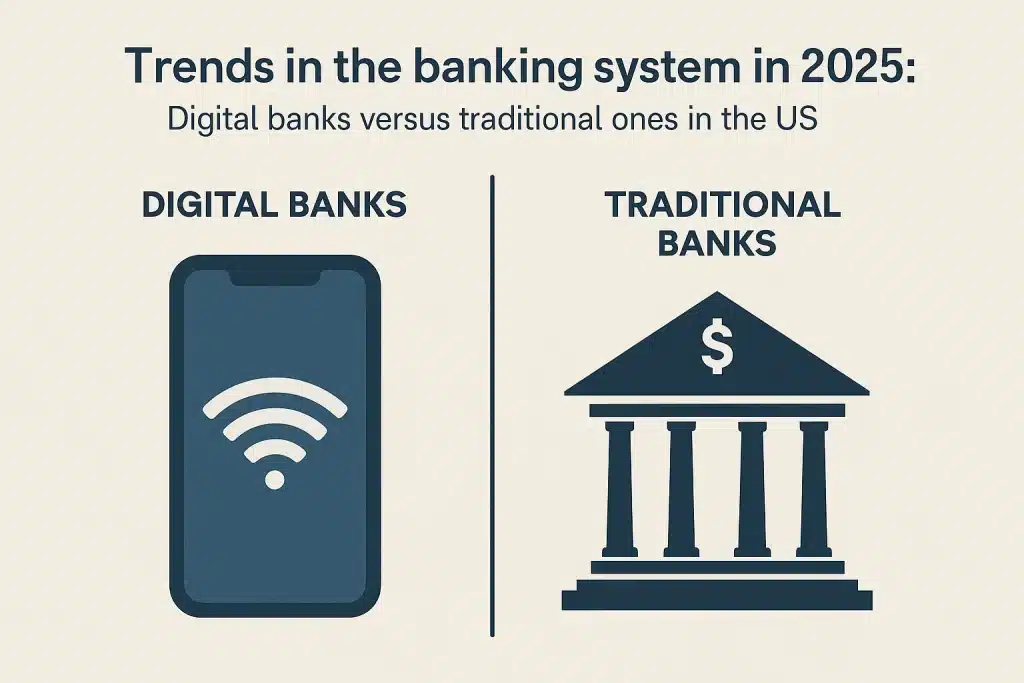In recent years, the realm of finances has experienced a transformative shift, especially in the United States. As we edge closer to 2025, the landscape is increasingly dominated by emerging digital institutions challenging the long-standing traditional banking entities. Digital banks offer convenience and cutting-edge technology, while conventional ones lean on trust and familiarity.
The digital transformation in the banking industry is not confined to a select few regions; it’s a broad movement affecting both consumers and banking institutions alike. Opting between modern mobile applications and tried-and-true banks is a decision more U.S. customers are facing, as both choices come with distinct advantages and limitations. Understanding these contrasts is crucial for consumers aiming to make well-informed decisions regarding their money management practices.
The rise of digital banks

The surge in digital banks marks a revolutionary period in financial services. These tech-focused institutions cater to digital natives who prioritize speed, efficiency, and user-friendly interfaces. With features like instant transactions, AI-driven customer support, and seamless integration with other digital services, digital banks cater to a fast-paced lifestyle.
The digital banking model places emphasis on convenience and accessibility. Without the infrastructure of physical branches, these institutions operate online, allowing customers the flexibility to bank from anywhere. The enhanced security features, like biometric authentication and real-time monitoring, further bolster the appeal of these banks to tech-savvy individuals keen on protecting their financial data.
Technological advancements driving growth
Technological innovation plays a crucial role in the explosive growth of digital-only banks. These institutions leverage machine learning and artificial intelligence to offer personalized financial advice, fraud detection, and customer service. The integration of mobile payment solutions and digital wallets make transactions seamless and encourage users to adopt a cashless lifestyle.
As blockchain technology advances, digital banks are poised to integrate these features more widely, potentially altering the way transactions are verified and executed. Such enhancements provide a promising outlook for the future of digital finance, providing users with more efficient and secure services.
Challenges faced by traditional banks
Even with the rapid advancement of digital banks, traditional institutions continue to play a significant role in the financial sector. The main struggle for these established banks is modernizing their services to remain competitive. Some have embraced digital transformation efforts, implementing mobile apps and online service offerings to attract tech-oriented clientele.
However, legacy systems and bureaucratic inertia pose challenges in swiftly adopting new technologies. Customers are often attracted to the reliability and established trust that comes with conventional banking services, such as physical branches and face-to-face interactions. Balancing innovation with their traditional values will be imperative for these banks to maintain their relevance.
Strategies for adaptation and growth
Traditional institutions are exploring various strategies to compete with their digital-only counterparts. Partnerships and collaborations with financial technology companies allow them to incorporate innovative solutions and offer enhanced online banking experiences. By investing in technology upgrades and hiring tech-savvy personnel, these banks can improve their digital offerings.
Redefining customer engagement by personalizing services and offering flexible products is critical for winning over younger generations. Educating customers about digital services and providing smooth transition paths from brick-and-mortar to online can also help retain their existing clientele. Adopting new strategies will be paramount for traditional banks to adapt and thrive in a rapidly evolving market.
The future of banking: a blended approach
The future of the financial sector likely lies in a blended approach that combines elements from both digital and traditional banking models. Consumer preferences suggest that a hybrid solution offering the convenience and innovation of digital platforms along with the trust and reliability of traditional branches could prevail.
Banks that successfully integrate technology while maintaining personalized services and customer trust will stand out. As we move towards 2025, it becomes increasingly evident that adaptability will be key. Embracing technological change while preserving core banking values might be the formula for success in this transforming financial landscape.
